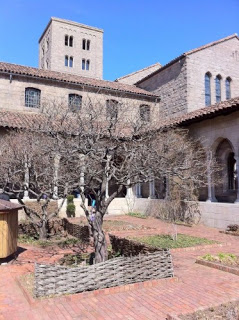Medieval History
 Paolo Dionisi Vici's life's work is preserving aging art made from wood. He gets misty-eyed encountering rare artifacts from his hometown in Tuscany. He looks strikingly like Frank Zappa.
Paolo Dionisi Vici's life's work is preserving aging art made from wood. He gets misty-eyed encountering rare artifacts from his hometown in Tuscany. He looks strikingly like Frank Zappa.
In other words, Dionisi Vici seems an unlikely person to get excited about the wireless sensors that are typically used to monitor the temperature of busy computers packed into IBM data servers. But that's exactly what he was excited about on April 6 in the busy halls of the Cloisters, the Metropolitan Museum of Art's upper Manhattan branch, which contains some 3,000 medieval works.
With technical assistance from IBM, Dionisi Vici, an associate research scientist for the Met, has deployed 120 low-power temperature and humidity sensors there since June of last year in his quest to determine the ideal environmental conditions for priceless wood works.
Click here to read this article from Technology Review
See also our profile of The Cloisters
- Lewis Chessmen Arrive In New York City
In 1831, a hoard of luxury goods?including more than 70 chess pieces and several other objects, all made of carved walrus ivory and dating from the 12th century?was unearthed on the Isle of Lewis off the west coast of Scotland. The chess pieces (thereafter...
- Introducing Children To Medieval Art
Inside a dark room in the Cloisters, 10 small children crowded around tapestries of men hunting unicorns. Their instructor, Britt Eilhardt, led them in a discussion of dogs, unicorns and why the Cloisters has a plant that is also in the Harry Potter books....
- Cloistered Away In New York City
Welcome to The Cloisters. It?s officially a part of the Metropolitan Museum of Art and it rests at the northern tip of Manhattan Island, in a beautifully remote woodland setting known as Fort Tryon Park. It takes its name from a series of five self-enclosed...
- Medieval Hebrew Manuscripts On Display At The Met
Two important medieval Hebrew manuscripts?a Mishneh Torah made between 1300 and 1400 in Germany and an illuminated leaf from a prayer book made in Austria around 1360?are on display in New York City at The Metropolitan Museum of Art and The Cloisters,...
- Reliquary Busts
Reliquary Bust of Saint Balbina, South Netherlandish, ca. 1520-30. Made in: Belgium, possibly Brussels, painted and gilded oak. The Metropolitan Museum of Art. Remarkable, isn't she? Her face is so expressive, representative of some of the period's...
Medieval History
An Algorithm for Preserving Art

In other words, Dionisi Vici seems an unlikely person to get excited about the wireless sensors that are typically used to monitor the temperature of busy computers packed into IBM data servers. But that's exactly what he was excited about on April 6 in the busy halls of the Cloisters, the Metropolitan Museum of Art's upper Manhattan branch, which contains some 3,000 medieval works.
With technical assistance from IBM, Dionisi Vici, an associate research scientist for the Met, has deployed 120 low-power temperature and humidity sensors there since June of last year in his quest to determine the ideal environmental conditions for priceless wood works.
Click here to read this article from Technology Review
See also our profile of The Cloisters
- Lewis Chessmen Arrive In New York City
In 1831, a hoard of luxury goods?including more than 70 chess pieces and several other objects, all made of carved walrus ivory and dating from the 12th century?was unearthed on the Isle of Lewis off the west coast of Scotland. The chess pieces (thereafter...
- Introducing Children To Medieval Art
Inside a dark room in the Cloisters, 10 small children crowded around tapestries of men hunting unicorns. Their instructor, Britt Eilhardt, led them in a discussion of dogs, unicorns and why the Cloisters has a plant that is also in the Harry Potter books....
- Cloistered Away In New York City
Welcome to The Cloisters. It?s officially a part of the Metropolitan Museum of Art and it rests at the northern tip of Manhattan Island, in a beautifully remote woodland setting known as Fort Tryon Park. It takes its name from a series of five self-enclosed...
- Medieval Hebrew Manuscripts On Display At The Met
Two important medieval Hebrew manuscripts?a Mishneh Torah made between 1300 and 1400 in Germany and an illuminated leaf from a prayer book made in Austria around 1360?are on display in New York City at The Metropolitan Museum of Art and The Cloisters,...
- Reliquary Busts
Reliquary Bust of Saint Balbina, South Netherlandish, ca. 1520-30. Made in: Belgium, possibly Brussels, painted and gilded oak. The Metropolitan Museum of Art. Remarkable, isn't she? Her face is so expressive, representative of some of the period's...
